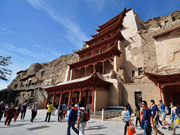Mogao Grottoes struggling with increasing tourists

 0 Comment(s)
0 Comment(s) Print
Print E-mail CNTV, November 25, 2014
E-mail CNTV, November 25, 2014
The Mogao Grottoes, located in northwest China's Gansu province, are among the most visited sites along the Ancient Silk Road. But their growing popularity over the years has led to a surge in tourism, presenting a tough challenge in making sure the 1,600-year-old site is protected.
 |
|
The Mogao Grottoes, located in northwest China's Gansu province, are among the most visited sites along the Ancient Silk Road. |
Authorities in charge of protecting the site have recently adopted new measures to ensure the area's beauty will be around for generations to come.
It is November in the city of Dunhuang when the chill of winter slowly starts to set it. On the west end of the Gansu Passage, is a scenic spot that receives more 500 visitors every day.
Since August, visitors have been able to book tickets online to visit the site, which led to a flood of admissions.
"It's quite convenient to book my ticket on the Internet. One can prepare for the visit beforehand," said a visitor.
Another change is that after entering the scenic zone, visitors are asked to watch a film about the site's history before they begin their tours in the caves.
"It turns out 97 percent of the visitors respond positively with the integration of watching digital film and visiting actual grotto," said Li Ping, Dunhuang Research Academy.
The mandatory film puts an extra 60 yuan on the ticket price, and the time one can spend in the historic grotto is limited to 75 minutes. The theater has received more than 240,000 visitors since opening.
"It is understandable that the visiting time should be limited as it may damage the historic frescos with so many people pouring in and out," said a visitor.
The grotto has a history of more than 1,600 years. In 1987, it was listed as a World Cultural Heritage by UNESCO.
Thanks to the area's dry weather and steady temperatures in the caves, the statues and frescos have been kept intact. But the surge of tourists in recent years has taken its toll. The zone receives more than 7,000 visitors every day in the summer season and even more during the National Holiday.
"During the National Holiday, we see some 20,000 visitors every day. The line could wind all along here, just for seeing one cave. They joke that one can see far more people than Buddha. When the crowds get in the cave there's only a small entrance, it is hard to breath and the air is smelly," said Chen Jin, a guide.
The exploding number of tourists have had an irreversible impact on the frescos.
"When Marc Stein stole the frescos in 1908, he took photos. We compare the photo with the frescos now and see a big difference. We are very worried as it has degraded so much," said Fan Jinshi, Director of Gunhuang Research Academy.
"When humidity passes over 62.5 percent, the salt crystals will dissolve and cause the frescos swell and fade," said Wang Xiaowei, State Admin. of Cultural Heritage.
Keeping the site's beauty intact for future generations to enjoy remains a tough task for the city.






Go to Forum >>0 Comment(s)